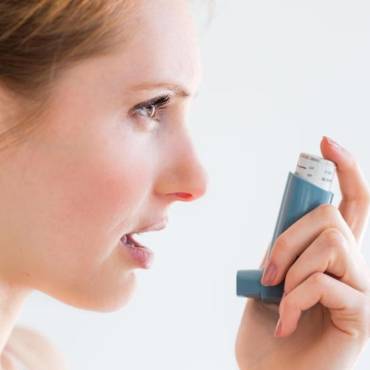Asthma triggers are irritants that aggravate the lungs and trigger an asthma flare-up. The best way to prevent an asthma attack is to avoid triggering an asthma episode and to take asthma medications. Ventorlin inhaler helps to relieve symptoms of asthma.
Asthma is a long-term respiratory illness that affects your lungs. It causes repeated episodes of breathlessness, wheezing, chest tightness, and coughing in adults and children. If you have asthma, you have it for the lifetime, but you may experience an episode of asthma only when allergens affect your lungs. If someone in your family has asthma, you are more likely to have it. It is tough to identify what causes asthma and how to cure it in most cases. However, knowing the warning signs of an asthma attack can help you control your condition. Staying away from things that give rise to an asthma flare-up and following your health care specialist’s advice will help you control asthma. Your health care adviser may recommend asthma medications that you need to use it as per instructions. Ventorlin inhaler may help relieve chest tightness, coughing and wheezing caused by asthma.
What causes an Asthma attack?
An asthma attack can occur, or your respiratory illness worsens when exposed to certain allergens in the environment such as dust mites in house and tobacco smoke. These are often termed as asthma triggers. Some Important asthma triggers are given below:
- Indoor Allergens- Asthma flares from indoor allergens are common in kids with allergies. These include dust mites, mice, cockroaches, and pet dander. Dust mites are found in almost everyone’s house, but they do not become the reason for initiating an asthma attack in everybody. If you have asthma, dust mites may cause you to have a sudden asthma attack. They can trigger an asthma episode year-round, and most are found in the home, in school, and office. To help prevent asthma flare-ups, use mattress covers and pillowcase covers to make a barrier between mites and yourself. And make sure you change your bedsheet and covers regularly. Also, remove stuffed animals and clutter from your bedroom. Those kids who are exposed to environmental smoke have more episodes of wheezing and longer-lasting asthma. Using a dehumidifier can also minimize indoor mould and allergens.
- Outdoor Allergens- Seasonal exposure to outdoor allergens can also trigger an asthma attack. Pollens, including trees, weeds, and grasses, are the most common outdoor allergens—pollen seasons based on where you live. Pollens shed in the spring season. Moulds are another common outdoor allergen that may make your asthma symptoms worse. They vary depending on the humidity and rain. To avoid indoor allergens, the goal is to decrease your exposure, thus preventing asthma flares. If you know that pollen is a trigger, you may help your child wash off the pollen after being outside. Let your child bathe after playing in the grass. Close your windows, especially during pollen seasons as this will help you reduce the exposure.
- Environmental Tobacco Smoke- It is often called second-hand smoke because it is smoke inhaled not by the individual who smokes, but by a second person nearby. If your child has asthma, you should stop/control smoking and never smoke around your child or any friend or relative with asthma. Make sure you only smoke outdoors and not inside your home or car. You should also not allow others to smoke in the home, and you should make sure that your kid’s school is smoke-free. Smoke can trigger you to have an asthma attack. Avoid being close to smoke from cigarette, cigars, pipes, grills, burning wood, and fireplaces. Other pollutants can also irritate your lungs and cause asthma flares. These lung irritants include smog, cleaning products, fragrances, and other chemicals. Ensure good ventilation when using cleaning products and other chemicals.
- Furry Animals- Pets are a common indoor allergen that can trigger asthma flares. Dog and cat furs can cause asthma exacerbation. A furry animal such as gerbils, rabbits, and hamsters can also cause asthma symptoms. The allergens can be present in the pet’s dander, saliva, and urine. If your allergic to pets, strict avoidance of the animal is recommended. When your furry per is suspected of triggering an asthma attack, the simplest solution is to find another owner for your furry one. Pets should be bathed weekly and kept outside as much as possible. You or child may not be allergic to your pet’s fur so trimming your pet’s fur will not make any sense. If you have a furry animal, use a vacuum cleaner to clean up anything at your home. If you have a wooden floor or tile, damp them twice a week.
- Outdoor Air Pollution- Smoke caused by industrial emissions and automobile exhaust can trigger an asthma attack. Give attention to air quality forecasts on television and radio and plan your outdoor activities accordingly. If air pollution aggravates your asthma, step outside only when air pollution is low.
Other Triggers
Strenuous physical exercise, certain medications, high humidity, thunderstorms, freezing temperatures, and some foods and additives can trigger an asthma episode. Emotional stress can also contribute to hyperventilation and thus, an asthma attack. It is important to take your asthma medications on time in every situation. Use Ventorlin inhaler under your doctor’s guidance.
Knowing what triggers your breathing problems will help you control your asthma. Taking asthma medications helps to prevent asthma symptoms. A Ventorlin inhaler is inhaled through the mouth to relieve breathing problems in asthma patients. When you are failed to avoid a trigger, be alert for a possible attack. Remember, it is possible to control your asthma!
Also Read: Is Honey good for Asthma?



